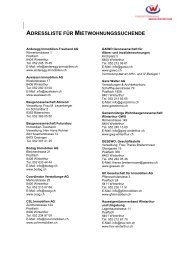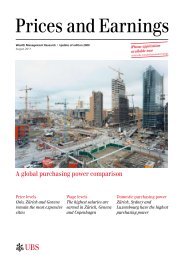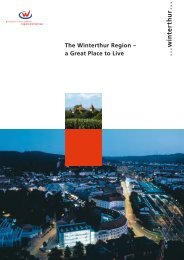Handbook for Investors. Business location in Switzerland.
Handbook for Investors. Business location in Switzerland.
Handbook for Investors. Business location in Switzerland.
You also want an ePaper? Increase the reach of your titles
YUMPU automatically turns print PDFs into web optimized ePapers that Google loves.
outes. The connection between Germany and Italy through the<br />
Gotthard Tunnel is of critical importance <strong>in</strong> Europe.<br />
In order to use <strong>Switzerland</strong>’s superhighways (Autobahn), every<br />
domestic and <strong>for</strong>eign motor vehicle weigh<strong>in</strong>g up to 3.5 metric<br />
tons must have a special highway sticker or «vignette» (currently<br />
CHF 40). The sticker is valid <strong>for</strong> a calendar year and can be<br />
purchased at customs and post offices, gas stations and railroad<br />
stations. No special tunnel fees are charged <strong>for</strong> us<strong>in</strong>g the Gotthard<br />
and San Bernard<strong>in</strong>o transalp<strong>in</strong>e tunnels.<br />
Trucks are subject to a heavy vehicle fee (HVF) based on kilometers<br />
driven <strong>in</strong> <strong>Switzerland</strong>, vehicle weight and emissions category<br />
(Euro 0 – III). For the route from Basel to Chiasso, 40-ton trucks<br />
can expect to pay a fee rang<strong>in</strong>g from EUR 180 to EUR 220.<br />
Vehicles over 3.5 metric tons are not allowed to travel on Swiss<br />
roads or highways at night or on Sundays.<br />
Federal Roads Office (FEDRO)<br />
www.astra.adm<strong>in</strong>.ch<br />
Languages: German, English, French, Italian<br />
Road traffic departments<br />
www.asa.ch<br />
Languages: German, French<br />
Customs <strong>in</strong><strong>for</strong>mation on kilometer-based heavy vehicle fee<br />
(HVF)<br />
www.ezv.adm<strong>in</strong>.ch<br />
L<strong>in</strong>k: Customs <strong>in</strong><strong>for</strong>mation <strong>for</strong> companies<br />
Languages: German, English, French, Italian<br />
11.1.2 Rail<br />
Because of the punctuality and reliability of their public transportation<br />
systems, the Swiss are the most frequent rail travelers <strong>in</strong> all of<br />
Europe. Every day, 9,000 tra<strong>in</strong>s run on the 3,000-km (1,865-mile)<br />
rail network operated by the SBB (Swiss Federal Railways). In addition<br />
to the SBB, there are a number of private railroad companies<br />
<strong>in</strong> <strong>Switzerland</strong> that operate on tracks cover<strong>in</strong>g somewhat more<br />
than 2,000 km (almost 1,250 miles). In spite of the fact that this rail<br />
network has the highest capacity utilization <strong>in</strong> Europe, the tra<strong>in</strong>s are<br />
very punctual. N<strong>in</strong>eteen out of every twenty passenger tra<strong>in</strong>s arrive<br />
at their dest<strong>in</strong>ation with<strong>in</strong> five m<strong>in</strong>utes of the scheduled arrival time.<br />
In order to protect the population and the environment, more and<br />
more freight traffic will be moved from road to rail <strong>in</strong> the future.<br />
Three major rail projects now underway will provide important<br />
benefits to <strong>Switzerland</strong> and Europe over the medium and long<br />
term. They will <strong>in</strong>crease transport capacity, reduce passenger<br />
and freight traffic on roads and highways, and help protect and<br />
preserve the ecologically sensitive Alp<strong>in</strong>e region.<br />
• Rail 2000: New l<strong>in</strong>es <strong>in</strong> <strong>Switzerland</strong>’s central region (Mittelland)<br />
will allow long-distance tra<strong>in</strong>s to run every half hour. They<br />
will optimize the connections between major centers and will<br />
ensure much shorter travel times.<br />
• AlpTransit or NRLA Project: The new Lötschberg and Gotthard<br />
transalp<strong>in</strong>e l<strong>in</strong>es are designed to provide new, fast north-south<br />
connections and facilitate substantial expansion of capacity<br />
and services. Long-distance travel times have been reduced by<br />
the Lötschberg base tunnel, which is 34 km (21 miles) long and<br />
already <strong>in</strong> operation. You can now get to Milan from Berne <strong>in</strong><br />
less than 2 3/4 hours. As <strong>for</strong> freight transport, the new Lötschberg<br />
base route helps meet a key goal of Swiss transport policy,<br />
which is to transfer transalp<strong>in</strong>e freight traffic from road to rail. It<br />
permits a substantial <strong>in</strong>crease <strong>in</strong> transport capacities, and the<br />
larger tunnel cross-sections allow heavier freight tra<strong>in</strong>s to pass<br />
through (shuttle profile). The AlpTransit or NRLA project («New Rail<br />
L<strong>in</strong>k through the Alps») is be<strong>in</strong>g built <strong>in</strong> stages. The Gotthard base<br />
tunnel, which is expected to be opened <strong>in</strong> 2016, will be the<br />
longest tunnel <strong>in</strong> the world at 57 km (over 35 miles).<br />
• L<strong>in</strong>k to the European high-speed rail network: Connection<br />
to the European high-speed rail network (TGV and ICE) will<br />
make <strong>Switzerland</strong> the most important hub <strong>in</strong> Europe’s future<br />
high-speed network. The Swiss government will <strong>in</strong>vest a total<br />
of CHF 1,090 million (2003 prices) <strong>in</strong> the rail network by the<br />
end of 2015 <strong>in</strong> order to provide better connections with the<br />
European high-speed network. This will shorten travel times<br />
from <strong>Switzerland</strong> to Paris, Lyon, Munich, Ulm and Stuttgart.<br />
<strong>Handbook</strong> <strong>for</strong> <strong>Investors</strong> 2010<br />
103









